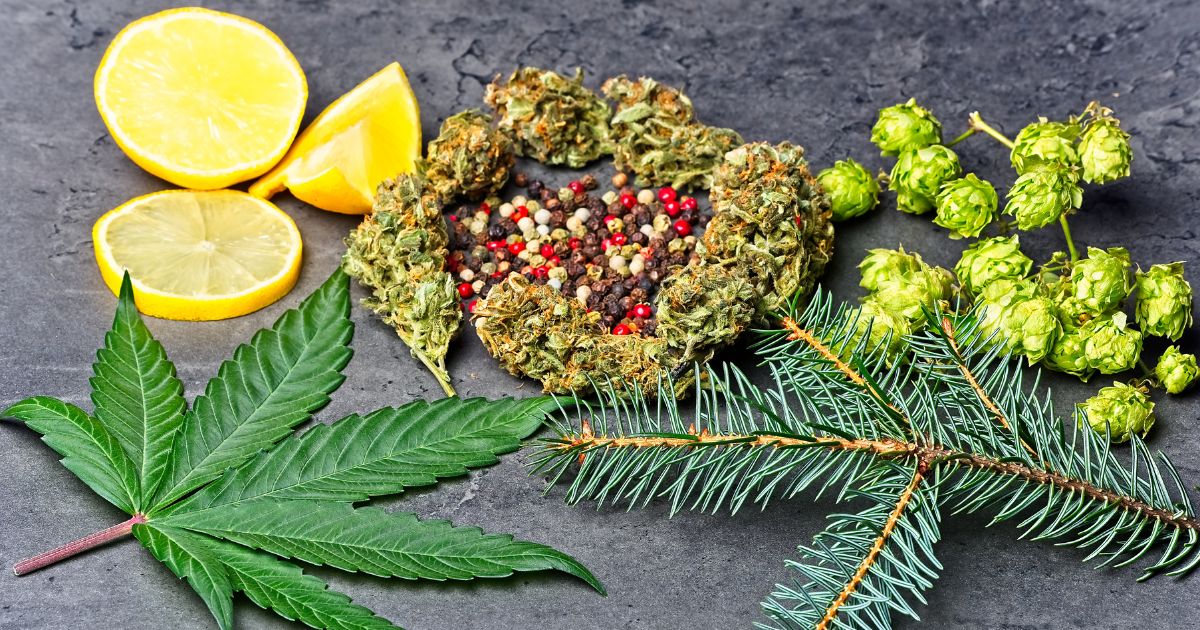Table of Contents
- The Chemistry Behind Farnesene
- Production and Biosynthesis of Farnesene
- Exploring the Therapeutic Benefits of Farnesene Terpene
- Farnesene in the Cosmetic Industry
- Farnesene in the Food and Beverage Industry
- Farnesene in the Fragrance Industry
- Farnesene in Cannabis
- Farnesene as a Natural Insect Repellant
- Conclusion
- Frequently Asked Questions
Terpenes, an incredibly diverse array of organic compounds in plants, is the secret behind their enticing aromas and flavours. Among these captivating compounds, farnesene stands out as a terpene with remarkable therapeutic potential and a plethora of versatile applications. In this comprehensive guide, we’ll embark on an exciting journey to uncover the fascinating chemistry of farnesene, explore its intriguing biosynthesis, unveil its therapeutic treasures, and reveal its far-reaching uses across a multitude of industries.
The Chemistry Behind Farnesene
Farnesene’s Chemical Structure
Farnesene is a sesquiterpene with a complex structure that includes multiple double bonds, which contribute to its unique properties and functions. It consists of 15 carbon atoms derived from three isoprene units with a chemical formula of C15H24.
α-Farnesene and β-Farnesene: The Two Types of Farnesene
There are two main isomers of farnesene: alpha farnesene (α-farnesene) and beta farnesene (β-farnesene). Although they share the same molecular formula, their structural arrangements differ slightly, resulting in unique properties and applications for each isomer.
Production and Biosynthesis of Farnesene
Natural Biosynthesis in Plants
Farnesene is naturally produced by plants through a process called biosynthesis. This process involves a series of enzymatic reactions that convert simple molecules, like isopentenyl pyrophosphate (IPP) and dimethylallyl pyrophosphate (DMAPP), into more complex terpenes like farnesene.
Industrial Production Techniques
In addition to natural biosynthesis, farnesene can also be produced industrially using various techniques, such as chemical synthesis and microbial fermentation. These methods allow for large-scale production of farnesene, making it more accessible for various applications.
Exploring the Therapeutic Benefits of Farnesene Terpene
Anti-Inflammatory Properties
Farnesene has demonstrated anti-inflammatory properties, making it a potential candidate for treating various inflammatory conditions. Studies have found that farnesene can inhibit the production of inflammatory mediators, such as cytokines, and may even help alleviate pain.
Antioxidant Effects
Like many other terpenes, farnesene has antioxidant properties that can help protect cells from damage caused by free radicals. This damage can lead to various diseases, including chronic inflammation, cardiovascular diseases, and even cancer. By neutralizing free radicals, farnesene can contribute to overall health and well-being.
Antimicrobial Activity
Farnesene has demonstrated antimicrobial activity against various pathogens, including bacteria and fungi. This property makes it a potential candidate for developing new antimicrobial agents, particularly in light of increasing antibiotic resistance among many pathogenic organisms.
Potential in Cancer Treatment
Preliminary research has shown that farnesene may have potential as a therapeutic agent in cancer treatment. Some studies suggest that it can induce apoptosis (cell death) in cancer cells and inhibit tumour growth. However, more research is needed to fully understand its mechanisms and possible applications in cancer therapy.
Farnesene in the Cosmetic Industry
Farnesene has found its way into the cosmetic industry due to its various properties, including its pleasant aroma and potential skin benefits. It can be found in products like perfumes, lotions, creams, and soaps. Additionally, its antioxidant and anti-inflammatory properties may contribute to healthier, more radiant skin.
Farnesene in the Food and Beverage Industry
Farnesene can be used as a flavouring agent or a natural preservative in the food and beverage industry. Its antimicrobial properties help to prolong the shelf life of products, while its aroma and flavour can enhance consumers’ sensory experience.
Farnesene in the Fragrance Industry
The unique aroma of farnesene makes it a popular ingredient in the fragrance industry. It is a critical component in various perfumes, giving them a distinctive and pleasing scent. Its versatility allows it to blend well with other fragrances, creating unique and memorable olfactory experiences.
Farnesene in Cannabis
Cannabis plants contain a complex terpene profile, which plays a significant role in the plant’s aroma, flavour, and potential therapeutic effects. Farnesene is one of the common terpenes found in various strains of cannabis, sometimes in high concentrations. If you’re interested in learning more about terpenes in cannabis, this article provides a comprehensive overview.
Strains High in Farnesene
While the specific strains high in farnesene may vary, some strains are known to contain higher levels of farnesene than others. To explore strains with unique terpene profiles, including those high in farnesene, check out our category page for craft cannabis.
Effects of Farnesene on Cannabis
The calming effects associated with farnesene are believed to contribute to the overall therapeutic potential of cannabis strains containing this terpene. When combined with other terpenes and cannabinoids, farnesene may play a role in the entourage effect, enhancing the overall benefits of the cannabis plant. For a deep dive into the effects of cannabis terpenes, you can refer to this informative article.
Farnesene as a Natural Insect Repellant
Farnesene is found in the skins of green apples and serves as a natural insect repellant, protecting the fruit from various pests. This characteristic has led researchers to explore its potential as an eco-friendly alternative to synthetic insect repellents. By harnessing the insect-repelling properties of farnesene, we can develop new, sustainable pest control methods that benefit both agriculture and the environment.
Environmental Impacts and Sustainability
As with any natural resource, the production and use of farnesene can have environmental impacts. However, by utilizing sustainable production methods, such as microbial fermentation, the environmental footprint of farnesene can be reduced. Additionally, the use of farnesene as a biodegradable and renewable resource can help to decrease reliance on non-renewable petrochemicals, contributing to a more sustainable future.
Conclusion
Farnesene terpene is a fascinating compound with a wide range of potential applications and therapeutic benefits. From its use in the cosmetic, food and beverage, and fragrance industries to its potential role in treating various health conditions, farnesene is a versatile and valuable natural resource. As we continue to explore its properties and uncover new applications, farnesene will undoubtedly play a significant role in the development of new products and therapies.
Frequently Asked Questions
1. What is farnesene terpene?
Farnesene is a sesquiterpene found in various plants, characterized by its unique aroma and flavour profile. It has numerous potential applications and therapeutic benefits, including anti-inflammatory, antioxidant, antimicrobial, and insect-repelling properties.
2. What are the differences between α-farnesene and β-farnesene?
α-farnesene and β-farnesene are two isomers of farnesene. They share the same molecular formula but have slightly different structural arrangements, resulting in unique properties and applications for each isomer.
3. How is farnesene produced?
Farnesene is naturally produced by plants through a process called biosynthesis. Additionally, it can also be produced industrially using various techniques, such as chemical synthesis and microbial fermentation, allowing for large-scale production.
4. Can farnesene be found in cannabis plants?
Yes, farnesene is one of the common terpenes found in various strains of cannabis. Its presence in cannabis can contribute to the plant’s aroma, flavour, and potential therapeutic effects.
5. What industries can benefit from using farnesene?
Farnesene has applications across various industries, including the cosmetic, food and beverage, fragrance, and agriculture industries. It can be used as a flavouring agent, natural preservative, key component in perfumes, and an eco-friendly insect repellant.





